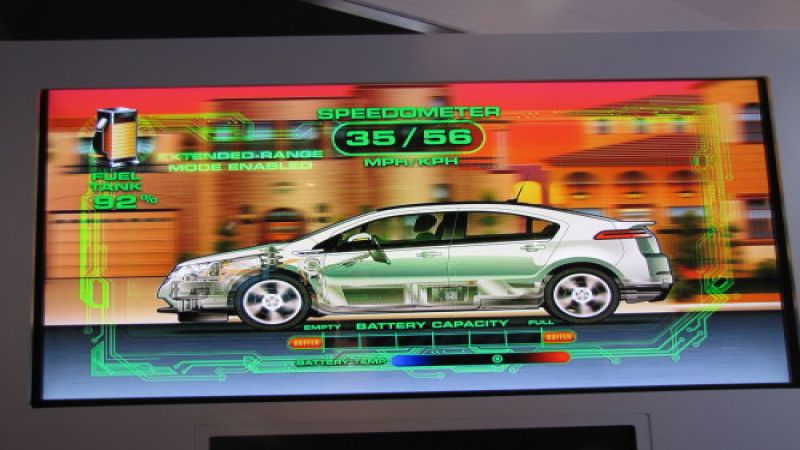Actual road tests are worth more than all the writers and engineering projections combined. So, be careful how writers and GM may spin the data.
For those who do a lot of highway driving, though, there seems to be no real stories to read, not even the person who drove his Volt back from the pickup point in New York.
Still, stories from new owners outweigh all the past theoretical calculations. So, the three Volts described in a GM news release revealed three distinct fuel economy stories that now tell us what we had all hoped.
Unlike most cars, where mileage differences vary slightly from driver to driver, the Volt defies conventional MPG measures, because it runs approximately 35 miles on a single charge of electricity to its 16 kWh battery, and then can travel another 344 miles on an onboard gasoline-powered electric generator that seamlessly kicks in when the battery is drained.
For example, since he took delivery of his 2011 Chevrolet Volt electric car with extended-range capability in December, Mike DiPisa of Lyndhhurst, N.J. is averaging 231 miles per gallon of gasoline. It’s because his 26-mile daily commute allows him to run almost gas free. His driving style is key.
“I haven’t filled up my Volt since I took delivery,” said. DiPisa. “Of the 1,485 miles DiPisa put on his Volt, 1,391 have used using grid electricity.
Granted, DiPisa’s fuel economy is on the high end of real-life experiences of early Volt owners, but it isn’t that unusual.
Matt Stehouwer of Lansing, Mich., says he’s getting 62 MPG after putting more than 1,500 miles on his Volt, including a drive from New York, where he took delivery of his car. Note there was no mention what his trip mileage was, though.
He commutes about 32 miles daily from his home to his job as Technical Manager at Michigan State University’s College of Natural Science.
Mike McCarver, a retiree from Los Altos, Calif., has traveled nearly 800 miles since he bought his Volt on Jan. 28, and he’s averaging 93 mpg. McCarver uses his Volt to travel around town, to the local country club, and occasionally to his vacation home in Carmel about 80 miles away.
For the record, the EPA’s label defined the Chevy Volt’s electric-only mode at 93 MPGe and the gas-only mode at 37. Question in many minds, including a few auto-related websites, centered on the average miles per gallon for a single trip that used one charge and one tank full of gasoline; in other words, a full cycle of dual-fuel use.
Previous Assumptions
My thoughts were, people would relate better if they had real numbers or a better way of calculating, as opposed to living with multiple opinions of auto writers, or spin reports from Chevy.
We already knew the Chevy Volt has a driving range of 379 miles. Also, for the record the 93 MPGe combined with 37 MPG for the 379 mile driving range is NOT the arithmetic average as many assume, including a few non-TN auto writers who should know better.
Point is, the line is not linear when dual-fuel use is involved, but a hyperbolic curve that flattens out to 37 MPG the further you drive; at least, that's been my assumption based on assessment.
The transition from "e" to gasoline appeared to me to be hyperbolic curve that flattens after 70 miles or so. So, to confirm that assumption, I asked my friend and former colleague, Bob Charbonneau, who was a math instructor. He said
You are right about the graph being nearly linear after more than 150 miles.
The max range (379 miles) trip will get you 39.2 mpg.
35 mi / 93 mpge = 0.38 gale used
344 mi / 37 mpg = 9.30 gal used
----------------------------- ----------------------
379 mi / 9.68 gal used = 39.2 mpg for a full tank trip.
He also wrote, “I know this (39.2 MPG average) seems low, but if you got your electricity for free, the 379 mile trip would still cost you 9.3 gallons = 41 mpg. The Volt is a very economical commuter with the ability to make long trips. On long trips it has average fuel economy for a small car. The problem is that in generator (gasoline) mode it has to carry the weight of the batteries.”
Conclusion
Based on the EPA ratings and my friend Bob's calculation for average MPG during transition, I viewed the Volt as not the best option for those who do a lot of highway driving. Fact is, there are more cost-effective vehicles that produce better gas mileage, like the Chevy Cruze. And I still hold that view.
Nevertheless, I still like this car. The main issue is, GM still has to get the cost down so the masses can afford it. That will take a while.
Bottom line for those who drive a lot on the highway? GM needs a more efficient generator engine for the Volt. It's that simple, or at least provide a natural-gas dual-fuel option. Then you would have a clean-burning car. Furthermore, this is not rocket science, and could be achieved very quickly.
-----------------------
About the Author: After 39 years in the auto industry as a design engineer, Frank Sherosky now trades stocks and writes articles, books and ebooks via authorfrank.com, but may be contacted here by email: [email protected]
________________________________________________
Additional Reading:
Smaller engines account for 46 percent of Chevrolet retail sales
Auto industry compromise with expensive EVs fails the masses
Scuderi Air-Hybrid Engine technology setting up to challenge electric hybrids
Cella Energy achievement may make hydrogen fill-up a reality
Stop-start technology to advance more micro hybrids by 2016
Four alternate engine technologies for 2011 and beyond











